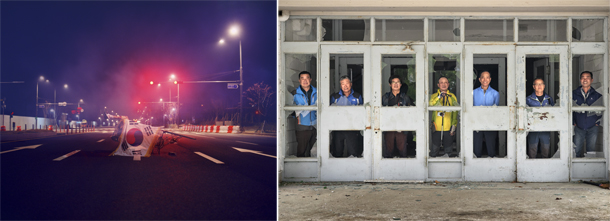Photos give voice to victims of state-sanctioned violence

Left: “A Night of Prayers” by the artist Oh Suk-khun interprets the Gwangju Uprising and the violence individuals faced from the state. Right: In artist Lim Jong-jin’s “Standing at Gwangju in March 2017,” people affected by the 1980 Gwangju Uprising stand in line at a spot that holds some of their most traumatic memories. [BUK SEOUL MUSUEM OF ART]
The mysterious sound may lure people inside the dark entrance of the “2017 Seoul Photo Festival
It depicts the forest that is presumed to be the place where the U.S. Army slaughtered about 300 Koreans on their way to seek refuge during the beginning of the war. The bodies of the dead were ultimately buried in the forest. The sound that accompanies the piece comes from the DMZ area. The growing sound, along with the flickering lights that shine on the dark forest, gives off the eerie feeling that the quiet massacre is slowly rising to the surface again.
Right next to “The Valley of Darkness” is a photo showing the naked backside of an old woman, revealing vivid scars of the bullets that have penetrated or brushed her body. She is known to be one of the few survivors of the massacre.
The work of the photographers and artists on display at the festival focuses on individuals who have been the victims of historical events. The individuals’ lives have been directly impacted by national affairs, and they still feel the impact to this day.
Through the photos, artists try to express the individuals’ points of view. Although the majority of the artists did not live through the turbulent times between the 1950s to 1980s, they worked closely with the victims, actively engaging in interviews and working hard to capture the right photos to exhibit in order for viewers to learn more.
Artist Lim Jong-jin’s photographs “Standing at Gwangju in March 2017,” “I am Not a Spy, 2017” and collections of photos taken by those involved in the 1980 Gwangju Uprising and the Samcheok Spy Ring in 1979 is evidence of the artist’s effort to highlight disputed moments in history. Lim actually met the victims of the two incidents and created a program to visit and photograph the places that caused them great pain.
The majority of the places have disappeared in the process of modernization, but the survivors can still accurately remember where the incidents took place.
“While visiting the spots where their self-esteem hit rock bottom - the moments are always vividly seared in their deepest pool of memories - the victims photographed the spots, and through the process, naturally mended the broken pieces of their minds,” Lim said.
“The scars of the incidents will always exist in the people’s memories, but at the very least I wanted to eliminate the shadows that tormented the people, which is something that the government failed to do.”
Likewise, the photographs and works displayed in the exhibition are unlike the beautiful or breathtaking photos that one usually sees at photography exhibitions. Moreover, they may look bizarre or eccentric, but the motives of the artists are clearly expressed through the photos and the explanations provided with their works.
The 2017 Seoul Photo Festival is divided into six parts: the Main Exhibition, Special Exhibition, Film Festival, Symposium, Project Exhibition and Citizens’ Photo Exhibition.
The six programs each present a different topic under the theme of “Community for Self-Reflection; State, Individuals and Us,” linking the actions of the past and current affairs with those who have been directly affected as well as the artists’ own perspectives.
BY LEE JAE-LIM [lee.jaelim@joongang.co.kr]










with the Korea JoongAng Daily
To write comments, please log in to one of the accounts.
Standards Board Policy (0/250자)